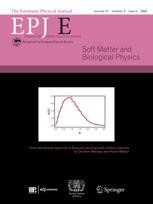Simulating microswimmers in nematic fluids
A combination of two simulation techniques has allowed researchers to investigate how swimming microparticles propel themselves through ‘nematic liquid crystals’ – revealing some unusual behaviours
New York | Heidelberg, 12 July 2021
 Artificial microswimmers have received much attention in recent years. By mimicking microbes which convert their surrounding energy into swimming motions, these particles could soon be exploited for many important applications. Yet before this can happen, researchers must develop methods to better control the trajectories of individual microswimmers in complex environments. In a new study published in EPJ E, Shubhadeep Mandal at the Indian Institute of Technology Guwahati (India), and Marco Mazza at the Max Planck Institute for Dynamics and Self-Organisation in Göttingen (Germany) and Loughborough University (UK), show how this control could be achieved using exotic materials named ‘nematic liquid crystals’ (LCs) – whose viscosity and elasticity can vary depending on the direction of an applied force.
Artificial microswimmers have received much attention in recent years. By mimicking microbes which convert their surrounding energy into swimming motions, these particles could soon be exploited for many important applications. Yet before this can happen, researchers must develop methods to better control the trajectories of individual microswimmers in complex environments. In a new study published in EPJ E, Shubhadeep Mandal at the Indian Institute of Technology Guwahati (India), and Marco Mazza at the Max Planck Institute for Dynamics and Self-Organisation in Göttingen (Germany) and Loughborough University (UK), show how this control could be achieved using exotic materials named ‘nematic liquid crystals’ (LCs) – whose viscosity and elasticity can vary depending on the direction of an applied force.
The duo’s discoveries could inform the future use of cargo-carrying microswimmers in delicate medical procedures: including drug delivery, disease monitoring, and non-invasive surgery. Through the use of biocompatible nematic LCs, these techniques could be easily and safely integrated with the bodies of patients. Typically, microswimmers propel themselves forward by either pushing or pulling the fluid surrounding them. So far, these motions haven’t been widely studied in less conventional fluids like nematic LCs – which have orderly crystal structures, but can also flow like liquids.
Mandal and Mazza studied this scenario using ‘multiparticle collision dynamics’ algorithms, which describe how the atomic structures of nematic LCs vary over time. Combined with simulations of spherical microswimmers, the algorithms allowed them to investigate how the direction-dependent viscosities and elasticities of nematic LCs can affect the speeds and orientations of spherical microswimmers. Previous studies showed that their motions are starkly different to those found in conventional fluids; with microswimmers following non-random trajectories to minimise their elastic energy. Mandal and Mazza now also show that a microswimmer’s speed will vary depending on whether it pushes or pulls the surrounding fluid; and also becomes slower when it pushes with a stronger force. The duo now hope that their simulation techniques could be easily extended to model the dynamics of multiple microswimmers.
References: S Mandal, M G Mazza (2021) Multiparticle collision dynamics simulations of a squirmer in a nematic fluid, Eur. Phys. J. E 44:64. DOI https://doi.org/10.1140/epje/s10189-021-00072-3
Further Information
For more information visit: www.epj.org
Services for Journalists
The full-text article is available here.
Contact
Sabine Lehr | Springer | Physics Editorial Department
tel +49-6221-487-8336 | sabine.lehr@springer.com
